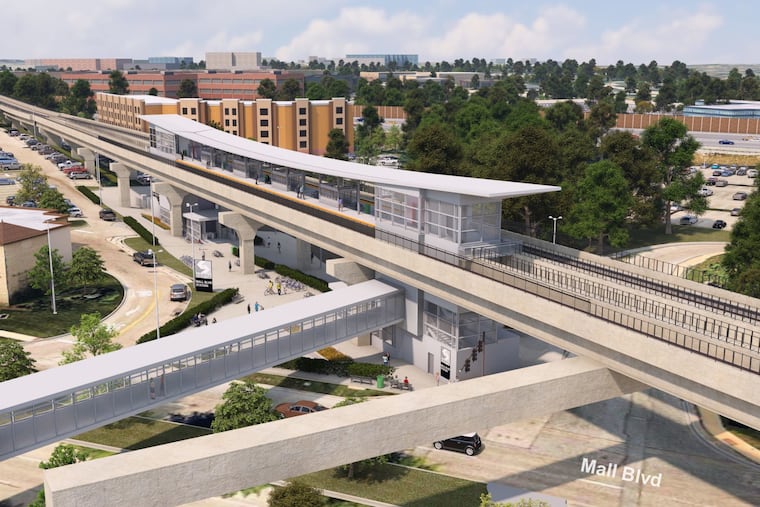A timeline of SEPTA’s expensive — now dead — KOP rail project
SEPTA had spent at least $53 million on the King of Prussia proposal when it announced work on the project stopped.

SEPTA’s King of Prussia extension of the Norristown High Speed Line was once expected to be carrying passengers in 2023. Instead, that’s the year SEPTA realized the line was unaffordable.
SEPTA on Friday announced that it’s stopping all work on the King of Prussia extension. The four-mile project was expected to cost more than $3 billion.
SEPTA first began studying how to expand transit access to King of Prussia in 2012 and held three public information sessions in early 2013 on the idea.
In 2014, two years after the expansion was first proposed, SEPTA officials said that securing funding for the project’s construction was still a hurdle.
“We have funds for about 30% of the design, but the big question is: How do we pay for the construction?” said Joseph M. Casey, SEPTA’s general manager at the time. “We need help — we need financial help — to get this going.”
Between 2015 and 2017, SEPTA held multiple public meetings to collect resident and rider feedback on the proposal, including on which routes seemed most viable and what the line should look like. Businesses began to back the rail expansion, while a group called NoKOPRail formed in opposition.
SEPTA struggled to fund the KOP rail project
Early estimates projected cost to be about $500 million, which ballooned to $1 billion by 2016. In 2019, SEPTA still had not secured total funding, and Upper Merion Township signaled it would not be contributing. The agency had said it never anticipated seeking direct funding from the township, and the lack of it wouldn’t be a significant setback.
“Unless there is some source of federal or state funding I’m unaware of,” said Greg Waks, then the chairman of Upper Merion’s Board of Supervisors, “I’m skeptical that $1.2 billion is a number they could achieve.”
The Pennsylvania Department of Transportation also was in a tight financial situation as SEPTA was seeking funding.
“Right now, the reality is, we’re not in a position to dedicate new funding to new projects,” said Jennie Granger, the state Transportation Department’s deputy secretary for multimodal transportation. “We’re looking at how we regain our current funding, just at that, not at expansion projects.”
SEPTA set out to develop a 20-year financial plan that it said would include a strategy to pay for the rail extension without affecting routine capital and operating budgets.
By 2022, the financial plan was still not complete, and estimated costs for the KOP rail costs had jumped to roughly $2 billion. The agency was seeking funding from the Federal Transit Administration’s (FTA) New Starts Program to cover up to 50%.
Earlier this month, the federal government declined to award the project a competitive capital grant for new transit.
How much has been spent on the KOP rail
SEPTA has spent at least $53 million on the KOP proposal so far for required studies and planning, said spokesperson Andrew Busch.
That includes $20 million left over from a congressional earmark in 2002 for the Schuylkill Valley Metro, a proposed rail line that would have connected Philadelphia and Reading, with service in between. SEPTA spent $33 million of its own capital funds on the KOP rail.
SEPTA last month awarded a $125 million contract to HNTB Corp., an architectural and engineering firm, for the final design work on the extension, the last step before construction. Busch said the contract had not been finalized, and SEPTA would not have to pay that bill.
KOP’s loss is not the Boulevard subway’s gain
Since the King of Prussia extension was announced, the project was widely met with criticism, some of which centered on the perception that SEPTA was focusing on expensive, suburban expansion rather that addressing service issues within the City of Philadelphia.
As SEPTA continued to push forward with the KOP rail project, renewed interest in a Roosevelt Boulevard subway extension began bubbling, and transit advocates began comparing the two potential rail lines.
The four-mile KOP extension would have been one of the country’s most expensive projects at roughly $3 billion, on a per-passenger basis, with projected daily ridership reaching about 10,000 passengers. A 2003 study estimated that a 12-mile Boulevard line would carry 124,000 riders a day and cost $3.4 billion to build ($7 billion today when adjusted for inflation).
In January, despite the increased public support for the Boulevard subway, SEPTA CEO and general manager Leslie S. Richards told the Philadelphia Business Journal, “With the limited amount of funds that we have right now, there really is no way forward [with the Roosevelt Boulevard subway]. The math just doesn’t work.”
Still, PennDOT announced in early March that it would conduct a new study on the Roosevelt Boulevard subway as a part of its Routes for Change program.